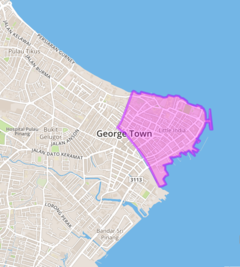Penang Chinese Town Hall
| 檳州華人大會堂 (Traditional Chinese) | |
| Predecessor | Goddess of Mercy Temple |
|---|---|
| Formation | 1881 |
Official language | Mandarin |
Building details | |
 | |
| General information | |
| Address | Pitt Street, 10200 George Town, Penang, Malaysia |
| Town or city | George Town, Penang |
| Country | Malaysia |
| Coordinates | 5°25′08″N 100°20′20″E / 5.4189°N 100.3390°E |
| Construction started | 1975[1] |
| Completed | 1978[1] |
| Inaugurated | 1983[1] |
| Technical details | |
| Floor count | 10[1] |
The Penang Chinese Town Hall was established in 1881.[2][3][4][5][6] Chung Keng Quee was the single largest individual donor towards the founding of the town hall and was a prominent president serving from 1881 to 1883.[7][8][9][10]
The main donors for the inauguration of the Penang Chinese Town Hall were the British Colonial Office (10,000 yuan), the Fukien Association (2,000 yuan), Ch'ao-chou Prefecture (1,800 yuan), Ch'iu Lineage Association (1,000 yuan), Hsieh Lineage Association (800 yuan), Cheng Ssu-wen (the fancy name of Chung Keng Quee) (600 yuan), and the Yang Clan of Ying-yuan kung (500 yuan). Two hundred and seventeen more donors contributed between 480 yuan to 10 yuan; a total of about 26,000 yuan was collected.[11]
In June 1905, Chinese merchants in Penang gathered in the Penang Chinese Town Hall, in support of the boycott on American goods, joining Singapore and China in putting pressure on the American government to improve its immigration policy towards the Chinese.[12][13]
In the election of the office bearer on 9 September 1906, Leong Lok Hing was made General President, Foo Choo Choon, Cheah Meng Chi, Chung Thye Phin and Lim Kek Chuan were made President, and Ng See Sin, Oon Boon Tan, Khaw Joo Tok, Quah Beng, Ong Hun Chong, Koh Leap Teng and Gnoh Lean Tuck were elected Vice President.[2][14]
On 22 June 2008 Penang Chinese Town Hall chairman, Tan Sri Lim Gait Tong said it was relevant to set up a special committee to establish the actual date it was founded because their records showed conflicting years in which the organisation was set up. He said that although the organisation's constitution stated that it was established in 1875, certain members had claimed that it was set up in 1881 and 1883.[15]
References[edit]
- ^ a b c d "History". www.pcth.org.my. Retrieved 2017-05-22.
- ^ a b Re-examination of the “Chinese nationalism” and Categorization of the Chinese in Malaya: The Case of the Chinese in Penang, 1890s-1910s by SHINOZAKI Kaori, Ph.D. student, Graduate School of Arts and Sciences University of Tokyo kaoris@pd.jaring.my presented at The Penang Story – International Conference 2002, 18-21 April 2002, The City Bayview Hotel, Penang, Malaysia (Organisers: The Penang Heritage Trust & STAR Publications)
- ^ Rites of Belonging: Memory, Modernity, and Identity in a Malaysian Chinese Community By Jean DeBernardi, Jean Elizabeth DeBernardi, Published by Stanford University Press, 2004 ISBN 0-8047-4486-6, ISBN 978-0-8047-4486-7 p.
- ^ 华侨华人大观 By Xinghan Zhang Compiled by 张兴汉 Published by 暨南大学出版社, 1990 ISBN 7-81029-000-2, ISBN 978-7-81029-000-5
- ^ A HISTORICAL SKETCH OF KONG HOCK KEONG by Tan Kim Hong published by Xiao En E-Magazine, Xiao En Cultural Foundation Archived 2011-07-19 at the Wayback Machine
- ^ Tan Kim Hong(陳劍虹)1987, The Chinese in Penang, a pictorial documentation(檳城華族歷史圖片輯).Penang: Penang Chinese Town Hall(檳州華人大會堂)
- ^ Chung Keng Quee, using his "fancy name" Cheng Ssu-wen is recorded to have donated 600 yuan according to the inscription on a memorial stone dated 1886 kept within the town hall.
- ^ Historical Personalities of Penang By Historical Personalities of Penang Committee, Published by Historical Personalities of Penang Committee, 1986; p. 47
- ^ Pioneer Businessman by Clarence Y K Ngui, published by Malaysian Business, Oct 16, 2003
- ^ Records and Recollections (1889-1934): Chinese Women, Prostitution & a Welfare Organisation By Neil Jin Keong Khor, Keat Siew Khoo, Izrin Muaz Md. Adnan Published by Malaysian Branch of the Royal Asiatic Society, 2004; p. 57
- ^ Chinese Epigraphic Materials in Malaysia: Collected, Annotated, and Edited by Wolfgang Franke and Chen Tieh Fan Published by University of Malaysia Press, 1982 (v.1-2), pp. 799, 802, 803
- ^ U.S. National Archives 1833-1906: June 23, 1905, July 4, 1905.
- ^ The Chinese Boycott: A Social Movement in Singapore and Malaya in the Early Twentieth Century by WONG Sin Kiong published in Southeast Asian Studies, Vo1.36, No.2, September 1998
- ^ Chen Jian Hong, “An Outline of Historical Development of the Chinese Town Hall” (陳劍虹,〈平章會館的歷史發展輪廓〉) in Committee for the Special Publication of the Penang Chinese Town Hall, op.cit., p142. Other office bears were Lim Hoa Chiam(林花鐕), general president; Qiu You Yong (邱有用), Luo Rong Guang (羅榮光), Xie Zi You (謝自友), Wu She Wang (伍社旺), Khoo Hun Yeang (邱漢陽), Chen Jin Long (陳錦隆), Yang Zhang Cai (楊章才), president; Heah SweeLee (連瑞利), Ooi Huck Boon (黃學文), Chen Zi Rong (陳子榮), Xie Wu Hu (謝五湖), Chen Zong Zhao (陳宗趙), Chee Si Teong (徐時忠), Lim Chum (林參), Wang Tian Xing (王天星), Cai Qi Feng (蔡奇逢), Cao Chi Fa (曹遲發), Zhao Qing Yun (趙慶雲), Teoh Soon Keng(張舜卿), Cai Shui Yi (蔡水義), Huang Zi Jing (黃子經), vice-president.
- ^ When was Town Hall founded? By : Lee Keng Fatt published on 23 June 2008 in the New Straits Times

